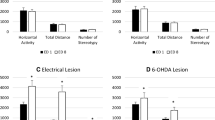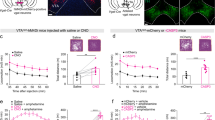Abstract
In the present experiments the behavioral response to substance P (SP) microinfusion into the ventral tegmental area (VTA), substantia nigra (SN), and sensorimotor cortex (CX) was investigated in detail. The experiments were carried out using an eight-hole box to measure exploratory behavior and a video monitor for the analysis of spontaneous motor behavior. When infused into the VTA, SP (0.125, 0.5, 3.0 μg) augmented the frequency and total duration of hole-pokes, and tended to diminish the mean duration of hole-pokes. The strategy and organization of responses, as measured by the order of hole-visits and hole-switching, were unchanged by SP and there was no indication of stereotypy, measured by the number of hole-pokes per hole-visit. The open-field analysis revealed a marked increase in locomotion and rearing, both in the periphery and center of the arena; grooming was decreased by SP. The behavioral profile following SN infusions of SP (3.0 μg) was similar to that elicited by VTA infusions, with the exception that center rearing was not enhanced. SP administration into cortex (3 μg) had no significant effect on any behavioral measures. It is hypothesized that SP infused into the ventral mesencephalon results in an enhancement of approach response tendencies, suggesting that endogenous SP in this region may regulate spontaneous behavior. The possibility of an interaction between SP and meso-telencephalic dopamine neurons is discussed.
Similar content being viewed by others
References
Bannon MJ, Elliott PJ, Alpert JE, Goedert M, Iversen SD, Iversen LL (1983) Role of endogenous substance P in stress-induced activation of mesocortical dopamine neurons. Nature 306:791–792
Beckstead RM, Domesick VB, Nauta WJH (1979) Efferent connections of the subtantia nigra and ventral tegmental area in the rat. Brain Res 175:191–217
Berlyne DE (1960) Conflict, arousal and curiosity. McGraw Hill, New York
Cador M, Kelley AE, Stinus L (1984) Behavioral analysis of the stimulatory effect of neurotensin injected into the ventral tegmental area of the rat. Proceedings of 14th Collegium Internationale Neuro-Psychopharmacologicum Congress, Florence, Italy, p 394
Chéramy A, Michelot R, Leviel V, Nieoullon A, Glowinski J, Kerdelue B (1978) Effect of immunoneutralization of substance P in the cat substantia nigra on the release from dendrites and terminals of dopaminergic neurons. Brain Res 155:404–408
Chéramy A, Nieoullon A, Michelot R, Glowinski J (1977) Effects of intranigral application of dopamine and substance P on the in vivo release of newly synthesized (3H) dopamine in the ipsilateral caudate nucleus of the rat. Neurosci Lett 4:105–109
Corey DT (1978) The determinants of exploration and neophobia. Neurosci Biobehav Rev 2:235–253
Cuello AC, Kanazawa I (1978) The distribution of substance P immunoreactive fibers in the rat central nervous system. J Comp Neurol 178:129–156
Eison AS, Iversen SD, Sandberg BEB, Watson SP, Hanley MR, Iversen LL (1982) Substance P analog, DiMe-C7: evidence for stability in rat brain and prolonged central actions. Science 25:188–190
Fallon JH, Moore RY (1978) Catecholamine innervation of the basal forebrain-IV. Topography of the dopamine projection to the basal forebrain and neostriatum. J Comp Neurol 180:545–580
File SE, Day S (1972) Effects of time of day and food deprivation on exploratory activity in the rat. Anim Behav 20:758–762
Glowinski J, Torrens Y, Beaujouan JC (1982) The striatonigral substance P pathway and dopaminergic mechanism. In: Ciba Foundation Symposium 91: Substance P in the nervous system. Pitman, London, pp 281–295
Hokfelt T, Johansson O, Ljungdahl A, Lundberg JM, Schultzberg M (1980) Peptidergic neurones. Nature 284:515–521
Iversen LL, Elliott PJ, Bannon MJ, Alpert JE, Iversen SD (1983) Interaction of substance P with dopaminergic neurones in brain. In: Skrabanek P, Powell D (eds) Substance P. Proceedings of the International Symposium. Boole Press, Dublin, pp 43–44
Iversen SD, Kelley AE, Stinus L (1979) Dose-dependent behavioral stimulation after local infusion of substance P into the ventral tegmental of the rat. Br J Pharmacol 66:113P
James TA, Starr MS (1979) Effects of substance P injected into the substance nigra. Br J Pharmacol 65:423–429
Jessell T, Iversen LL, Kanazawa I (1976) Release and metabolism of substance P in rat hypothalamus. Nature 264:81–83
Jolicoeur FB, Rondeau DB, Belanger F, Fouriezos G, Barbeau A (1980) Influence of substance P on the behavioral changes induced by haloperidol in rats. Peptides 1:103–107
Kelley AE, Domesick VB, Nauta WJH (1982) The amygdalostriatal projection in the rat-an anatomical study by anterograde and retrograde tracing methods. Neuroscience 7:615–630
Kelley AE, Iversen SD (1979) Substance P infusion into substantia nigra of the rat: behavioural analysis and involvement of striatal dopamine. Eur J Pharmacol 60:171–179
Kelley AE, Stinus L, Iversen SD (1979) Behavioural activation induced in the rat by substance P infusion into the ventral tegmental area: implication of dopaminergic A10 neurones. Neurosci Lett 11:335–339
Lat J, Gollova-Hemon E (1969) Permanent effects of nutritional and endocrinological intervention in early ontogeny on the level of non-specific excitability and on lability (emotionality). Ann NY Acad Sci 159:710–720
Ljungdahl A, Hokfelt T, Nilsson G, Goldstein M (1978) Distribution of substance P-like immunoreactivity in the central nervous system of the rat. II. Light microscopic localization in relation to catecholamine-containing neurones. Neuroscience 3:945–976
Pellegrino LJ, Cushman AJ (1967) A stereotaxic atlas of the rat brain. Appleton-Century-Croffts, New York
Pernow B (1983) Substance P. Pharmacol Rev 35:85–141
Prescott R (1970) Some behavioral effects of variable which influence general activity level of rats. Anim Behav 18:791–796
Roberts GW, Woodhams PL, Polak J, Crow T (1982) Distribution of neuropeptides in the limbic system: the amygdaloid complex. Neuroscience 7:89–131
Robbins TW (1977) A critique of the methods available for the measurement of spontaneous motor activity. In: Iversen LL, Iversen SD, Snyder SH (eds) Handbook of psychopharmacology, vol 7. Plenum, New York, pp 37–82
Robbins TW, Everitt BJ (1928) Functional studies of the central catecholamines. Int Rev Neurobiol 23:303–365
Somogyi P, Priestly JV, Cuello AC, Smith AD, Bolam JP (1982) Synaptic connection of substance P-immunoreactive nerve terminals in the substantia nigra of the rat. Cell Tissue Res 223:469–486
Starr MS, James TA, Gaytten D (1978) Behavioural depressant and antinociceptive properties of substance P in the mouse: possible implication of brain monoamines. Eur J Pharmacol 48:203–212
Stinus L, Kelley AE, Iversen SD (1978) Increased spontaneous activity following substance P infusion into A10 dopaminergic area. Nature 276:616–618
Stinus L, Kelley AE, Winnock M (1984) Neuropeptides and limbic system function. In: Trimble M, Zarifian E (eds) Psychopharmacology of the limbic system. Oxford University Press, London, pp 209–225
Valle FP (1970) Effects of strain, sex, and illumination on open-field behavior of rats. Am J Psychol 83:103–111
Waldmeier PC, Kam R, Stocklin K (1978) Increased dopamine metabolism in rat striatum after infusions of substance P into the substantia nigra. Brain Res 150:223–227
Author information
Authors and Affiliations
Rights and permissions
About this article
Cite this article
Kelley, A.E., Cador, M. & Stinus, L. Behavioral analysis of the effect of substance P injected into the ventral mesencephalon on investigatory and spontaneous motor behavior in the rat. Psychopharmacology 85, 37–46 (1985). https://doi.org/10.1007/BF00427319
Received:
Accepted:
Issue Date:
DOI: https://doi.org/10.1007/BF00427319




